Big Bottom
Hmmm, wondering if the L-Acoustics K1 Coachella system be referred to in the male or the female context. What do ya think? I can think of some big reasons it could go either way. Though I am tending towards pushing the feminine angle and so with that said, how about we take a good look at her bottom end?
**** Begin Un Censored Sound Nerd Speak ****
RATED Triple N (Must be an advanced nerd to read)
Quite a bit of thought was put into the subwoofer setup for Coachella Main Stage. I had the honor to work with Scott Sugden from L'Acoustics on the subwoofer design and it was really fun. The first thing we did was outline the goals to be achieved:
1) The design must be appropriate looks and location wise. By that I am referring to avoiding an awkward sub setup like one that pushes the barricade out too far or those super tall sub stacks that block video screens and look terrible. The goal is for speakers to be heard, not seen and if it is seen, it should look clean and fit into the look of the stage.
2) The design must be repeatable. I wanted to avoid a 'custom Coachella setup' that relies on taking advantage of unique aspects of the event or placement locations. The goal was to design a sub configuration that could be dropped into any field show and archive impressive results.
3) The design must be scalable. This is pretty simple to hit, but important none the less.
4) The design must be simple to implement. I wanted to avoid a setup that requires taking a bunch of complex time consuming measurements and extensive onsite testing that requires blasting subs for an extended time frame. We want simple, easy and very little room for error.
5) The design must have flexible dispersion/coverage capabilities. One of the coolest aspects of the sub cannon setup I used on Peppers tour was that I could easily widen the sub coverage pattern by increasing the level of the side firing boxes. If the arena sold farther around the sides, I could easily increase the coverage to well beyond 180 degrees. For the Peppers field setup with sub cannons, I could widen and narrow the coverage. We wanted to retain that flexibility while improving other aspects.
6) The design must not involve destructive sound. By that I mean that I did not want any boxes that are used to cancel out sound. Out of polarity rear firing speakers used create cardioid patterns are an un acceptable solution. I also wanted to avoid that whole beam steering thing where a whole bunch of graduated delay times are used to electronically focus. One or two delays I am fine with, but beyond that, too scary and my experience with electronic beam steering is it is one of those 'two steps forward and one step back' scenarios where side effects of db loss and complex coverage patterns negate many of the advantages.
7) The system must be able to convert to conventional sub woofer setup without moving speakers. There will be over 30 engineers mixing on the system at these festivals and we need a setup that will make everyone happy, so it needs to be able to switch to a normal-ish sub setup, should any engineer so desire.
8) The subwoofer coverage of the event must be impressive. The big challenge with subwoofers is that you are fighting two main issues. First is that the wider the subwoofer setup is, the narrower the coverage is. Secondly, the reduced horizontal coverage issue can be addressed by stacking the subs into two tall vertical arrays BUT, those vertical arrays cause these huge V shaped cancellation nodes. If you have mixed on a system with vertical subwoofer arrays, I am sure you have noticed those huge holes just to either side of power alley where there is practically no sub lows. To me, that is an unacceptable ramification.
9) The design must utilize the L-Acoustics SB28 sub woofers. Hey, they are part of our new K1 system and we are keeping the whole deal together and matched up and these subs are awesome!
10) The design should minimize low end bleed onto the stage. On a show this size where we are pumping low end over long distances, it is critical that we can deliver the needed energy deep into the audience with out overpowering our musical friends on stage just a few yards away from the subs.
So as the ideas bounced back and forth, it began to evolve in what seems in retrospect to be the obvious path. Lets combine the SB28's cardioid configurations with a version of the sub cannon configuration.
Before I go on, it is important to note that the L-Acoustics cardioid sub setup does not implement out of phase sound to cancel the rear propagation. Rather, it the rear firing sub is set at zero time delay and the front fire subs 'wait' for the sound of the rear sub to wrap around and then augment that sound. That means that in front of the cardioid array, all 4 boxes are in correct time. But as you walk around behind the boxes, the is a time error increases. This causes an effective cancellation behind the boxes while in front of the boxes it is all in time and good, hence 'cardioid.' Basically it is the same concept as the sub cannons except it requires less physical depth.
So the first thing we did was run some analysis on the arena and field sub cannon setups as well as numerous other interesting and cool sub layouts that Scott has implanted and pondered. What we ended up with is a 6 cluster setup. The primary cardioid sub cluster consist of 6 forward facing and 2 rear facing SB28's set at what we will refer to as 'zero time delay.' The next set of clusters had acoustic centers located 1/3 of a 40 hz wavelength to the outside of that. These outside clusters are the 'cannons' and are laid back in time by 1/6th of a wavelength at 40 hz, such that they augment the sub energy radiated 33 degrees off axis and create a cancellation on stage. These outside clusters consisted of 4 SB28's forward with 2 rear facing.
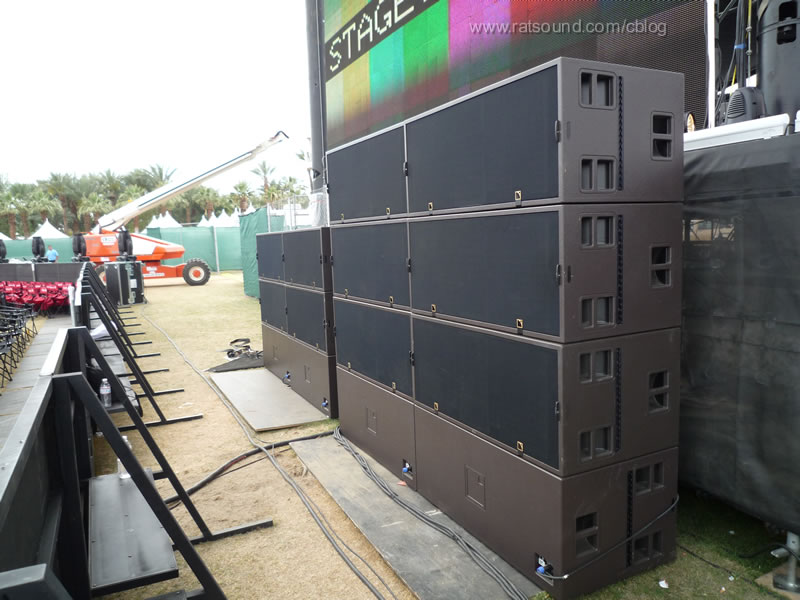
Finally, there are two small 2 box cardioid clusters just to the left and right of center. These serve two purposes. They act as center fill subs to even out the low end hole that created by being off axis to the main subs and also they act allow us to widen power alley and create an extremely smooth subwoofer coverage.
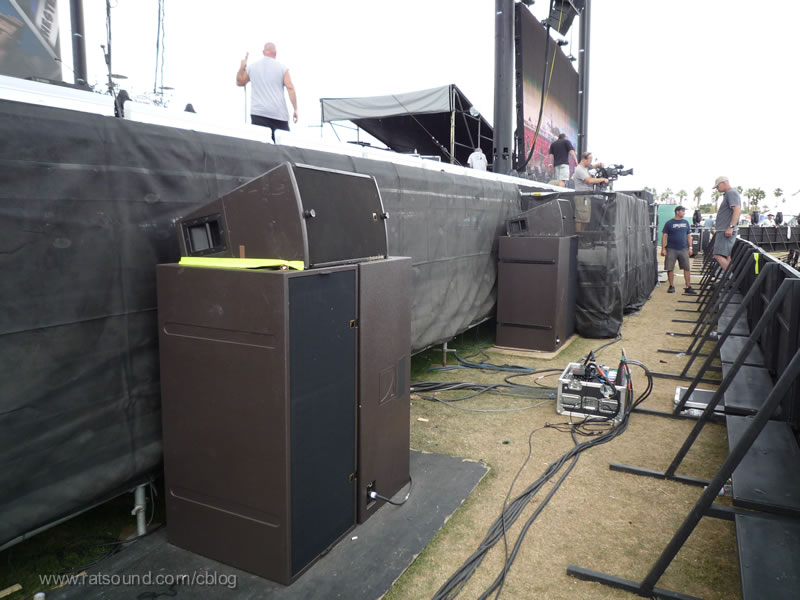
So maybe that sounds complex or maybe not but either way, the result is simple. Turn up the outside clusters and the coverage expands wider, turn them down and it becomes narrower. Turn up the center sub cluster and the power alley effect is reduced, turn them down and power alley increases. All this was achieved with only two very time delay settings and well thought out but simple stacking locations.
Ha! Well hopefully that got your mind spinning!
**** End Un Censored Sound Nerd Speak ****
While were are diving into all kinds of cool and exiting stuff, check out the MicroWedge 12 Case design. What do ya think? A one human operation to open and close the case.
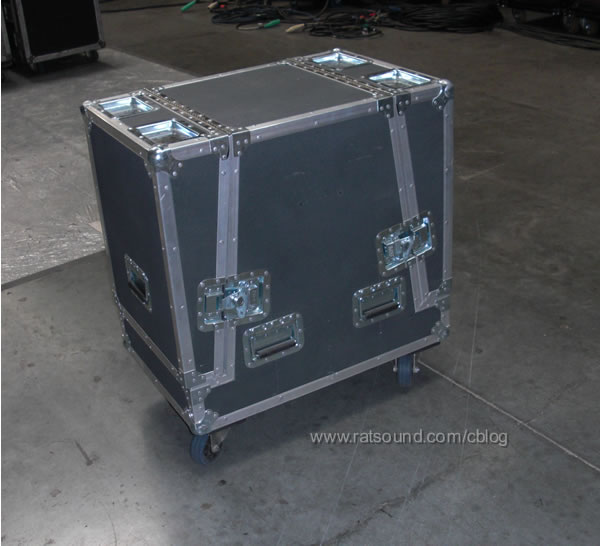
Plus storage inside for cables, tripod mounts and MicroLegs means the case is fully self contained with all you need after the amp.
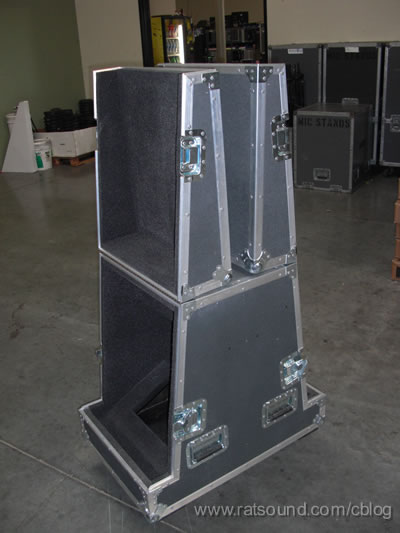
Here is the bottom storage, there is another compartment up top as well.
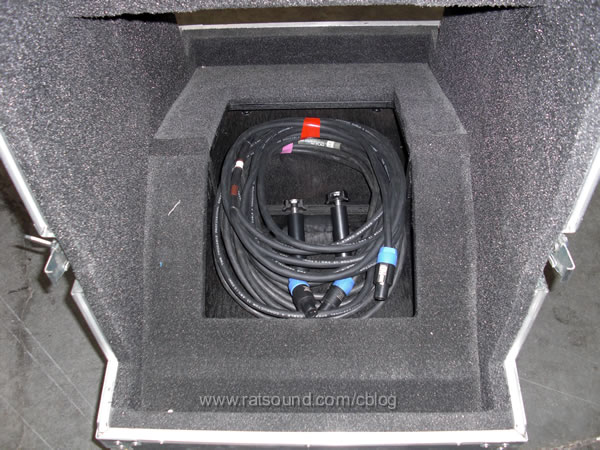
Â
I am not through yet, much more to come, like a whole series of arm reach self photos with cool Rat crew and the rock stars of the sound nerdery world. And lastly but not leastly, I would like to mention a new drink that a few of the sound crew has come up with. Vodka straight shots followed quickly with a Vodka straight chaser. Gotta be quick though and hit the chaser before the burn of the shot sets in and be sure to use two different kinds of vodka. Ha! Just kiding or maybe not.
Dave Rat feeling a little mini road fun that I so miss and so happy to be hanging with 'my people.'.